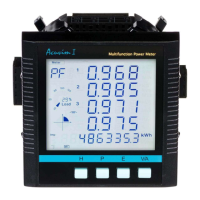89
operation, TOU function will be disabled.
6. Tari setting parameter: This parameter corresponds to the number of taris
available for the TOU calendar and can be selected from any integer from 0 to 3.
The four taris: sharp, peak, valley and normal are represented by 4 integers: 0,
1, 2 and 3 respectively. If the tari setting parameter is set to 3, all of the 4 taris
will be available for the TOU calendar; if the parameter is set to 1, only the rst 2
taris (sharp and peak) will be available.
7. Holiday setting parameter: This parameter can be set from any integer
between 1 and 30, meaning a maximum of 30 holidays can be programmed to
the TOU calendar. If the holiday setting parameter is set as 3, the rst 3 slots of
the holiday schedule must be set, otherwise it will be considered as an invalid
input (TOU function will be disabled).
Note: User can either customize the TOU calendar factory settings or use the
default factory settings. User can reset the TOU calendar to its default value
either via communication or from the meter front.
8. Holiday schedule: The holiday schedule uses the same format as the TOU
seasons “MM-DD ID”. User can select which TOU schedule to be used for the
holiday. The dates of the holiday schedule do not need to be organized in
a sequential order (i.e. the first slot can be January 1, the second slot can be
December 26 and the third slot can be December 25).
9. Daylight saving time (DST): Daylight saving time can be enabled in one of two
formats: The xed date option, or a xed day of one of the weeks in the month
(also named as the non-fixed date option). if you choose a fixed date option,
you set the format according to a xed date, for the daylight saving time switch:
the format month / day / hour / minute / adjust time (in minutes). If you choose
non-xed date option, DST will be implemented by which day of which week,
whose setting format is month/which day (i. e. Tuesday)/which week (i. e. 1st

